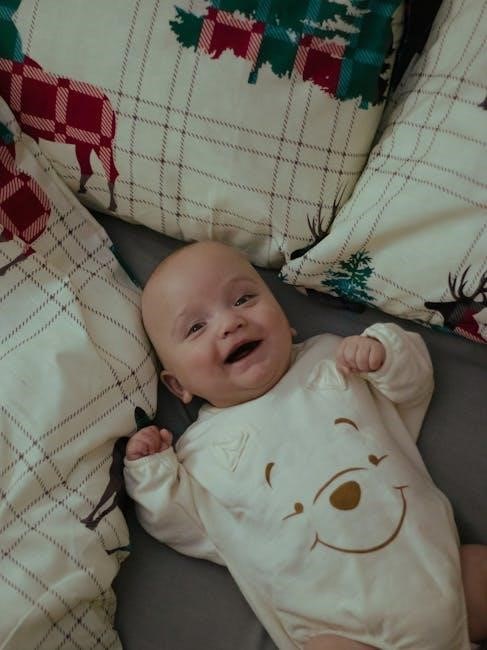Baby Reindeer is a gripping monologue by Richard Gadd, exploring obsession and delusion through a chance encounter. Premiering at Edinburgh Fringe, it became a critically acclaimed, haunting narrative available as a PDF for educational purposes.
What is “Baby Reindeer Play”?
Baby Reindeer Play is a critically acclaimed monologue written by Richard Gadd, exploring themes of obsession, delusion, and the aftermath of a chance encounter. Premiering at the Edinburgh Fringe Festival in 2019, it has since gained widespread recognition for its raw, unsettling narrative. The play follows a struggling comedian, Donny Dunn, whose life spirals due to an enigmatic figure, Martha Scott. It delves into psychological complexity, blending dark humor with intense drama, and is now available as a PDF for educational and theatrical use, offering insights into its powerful storytelling and character development.
The Concept of the Play
Baby Reindeer Play revolves around a chance encounter that spirals into obsession and delusion, exploring the thin line between reality and fantasy. The narrative delves into psychological complexity, using simple yet heavy dialogue to depict the protagonist’s descent into chaos. Through everyday interactions, the play examines how one decision can reshape a life, blending comedy with intense drama. Its concept challenges perceptions of victimhood and justice, offering a raw, unsettling perspective on human behavior and the consequences of obsession.

Background and Development
Baby Reindeer, written by Richard Gadd, premiered at the Edinburgh Fringe in 2019, later transferring to the Bush Theatre and West End, earning multiple awards.
The Story Behind “Baby Reindeer”
Baby Reindeer begins with a simple act of kindness: Donny Dunn, a struggling comedian, offers a free cup of tea to Martha Scott, a distraught customer. This chance encounter spirals into obsession as Martha becomes a regular at the pub, sharing elaborate stories and claiming to be a wealthy lawyer; Donny, intrigued by her enigmatic presence, becomes entangled in a relationship marked by manipulation and stalking. The play explores the psychological fallout of their toxic dynamic, delving into themes of obsession, delusion, and the devastating impact of a seemingly innocent interaction.
Richard Gadd’s Vision and Creation
Richard Gadd’s vision for Baby Reindeer stems from his personal experiences, blending raw emotion with dark humor. He crafted the play as a monologue to emphasize Donny’s isolation and internal struggles. Gadd’s creation explores themes of obsession, delusion, and trauma, offering a gripping narrative that challenges the audience to question victimhood and justice. The play’s intense, anxiety-ridden atmosphere reflects Gadd’s intent to provoke thought and emotional resonance, making it a powerful theatrical experience.
From Stage to Screen: The Journey of the Play
Baby Reindeer began as a stage play, premiering at the Edinburgh Fringe Festival in 2019, before transferring to the Bush Theatre and London’s West End. Its success led to a TV adaptation, with Richard Gadd penning the script for Netflix’s 2024 series. The show follows Donny Dunn, a comedian entangled in a haunting relationship with Martha Scott. Episode 4 highlights Donny reporting Martha to the police, uncovering buried memories and a traumatic encounter with Darrien. The series maintains the play’s dark humor and emotional depth, offering a fresh yet faithful adaptation of Gadd’s original vision.

Key Themes and Messages
Baby Reindeer delves into obsession, delusion, and trauma, questioning victimhood and the justice system. It portrays how one encounter reshapes a life, blending dark humor with profound emotional depth.
Obsession and Its Consequences
Baby Reindeer explores the destructive power of obsession, tracing how a seemingly harmless encounter escalates into a life-altering fixation. The play portrays the fine line between fascination and delusion, as Donny becomes entangled in Martha’s enigmatic presence. This obsession spirals into emotional turmoil, leading to a breakdown of control and rationality. The narrative vividly illustrates how obsession can consume an individual, blurring reality and fantasy, with devastating consequences that ripple through every aspect of life. It serves as a chilling reminder of the fragility of mental stability in the face of fixation.
Delusion and Reality: A Thin Line
Baby Reindeer masterfully explores the fragile boundary between delusion and reality, as Donny’s perception of Martha evolves from fascination to fixation. The play delves into how a single encounter can distort reality, leading to a blurred line between truth and fantasy. Donny’s grip on reality falters as Martha’s enigmatic presence dominates his thoughts, creating a world where obsession masquerades as truth. This psychological unraveling highlights the destructive potential of delusions, leaving the audience questioning what is real and what is imagined in Donny’s fractured narrative.
Trauma and Its Impact on Life
Baby Reindeer vividly portrays how a single traumatic encounter reshapes Donny’s life, leaving lasting emotional scars. The play delves into the aftermath of a chance meeting with Martha, which spirals into obsession and delusion. Donny’s career as a comedian falters, and his personal relationships crumble under the weight of his fixation. The narrative explores the profound impact of trauma on mental health, relationships, and overall well-being, showcasing how unresolved pain can dominate and distort one’s reality. This theme is central to the play’s haunting and thought-provoking structure.
The Justice System and Victimhood
Baby Reindeer examines the complexities of victimhood and the justice system’s role in addressing trauma. Donny’s decision to report Martha to the police uncovers buried memories, highlighting the legal system’s limitations in providing closure. The play critiques how victimhood is perceived and handled, revealing the emotional toll on Donny as the justice system fails to alleviate his suffering. This narrative thread underscores the struggle for accountability and the lasting scars of unresolved trauma, questioning the system’s ability to heal or protect.
Characters and Their Roles
Baby Reindeer centers on Donny Dunn, a struggling comedian, Martha Scott, an enigmatic figure, Darrien, a traumatic catalyst, and other characters shaping Donny’s turmoil.
Donny Dunn: The Struggling Comedian
Donny Dunn is the protagonist, a comedian whose life unravels after a chance encounter with Martha Scott. His struggle to balance humor with the darker aspects of reality drives the narrative. The play delves into his psychological turmoil, showcasing his descent into obsession and delusion. Donny’s character represents the fragility of mental health and the blurred lines between reality and fantasy. His journey highlights the consequences of unchecked emotions and the impact of past traumas on present decisions.
Martha Scott: The Enigmatic Figure
Martha Scott is a mysterious and manipulative figure central to the narrative. Presenting herself as a wealthy lawyer, she captivates Donny Dunn with intriguing stories, blurring the line between truth and fiction. Her fixation on Donny escalates, revealing a darker, obsessive side. Martha’s enigmatic nature and manipulative behavior drive the play’s exploration of obsession and delusion, making her a pivotal catalyst for Donny’s psychological unraveling and the trauma that follows.
Darrien: The Catalyst for Trauma
Darrien emerges as a pivotal figure in Donny’s life, encountered during the Edinburgh Fringe Festival. This unsettling meeting triggers a traumatic experience that profoundly reshapes Donny’s perspective. Darrien’s presence and actions act as a catalyst, unleashing a chain of events that delve into Donny’s psychological state and his struggle to cope with the aftermath. This interaction becomes a cornerstone of the narrative, exploring themes of trauma and its lasting impact on Donny’s life, making Darrien an indispensable element in the play’s dark and complex unraveling.
Other Characters and Their Significance
Beyond Donny, Martha, and Darrien, other characters play crucial roles in shaping the narrative. Minor figures like the Policeman, represented as a disembodied voice, add depth to Donny’s journey; These characters, often portrayed through voiceovers or brief interactions, reflect Donny’s internal struggles and perceptions. Their presence underscores themes of obsession, delusion, and trauma, while their absence highlights Donny’s isolation. Each character, no matter how peripheral, contributes to the play’s psychological complexity and emotional weight, enriching the exploration of Donny’s fractured reality.

Script and Dialogue
Baby Reindeer relies on simple yet powerful conversations to explore heavy themes. The dialogue captures everyday interactions, making the characters’ struggles and obsessions deeply relatable and hauntingly real.
The Power of Simple Conversations
Baby Reindeer masterfully uses simple, everyday dialogue to explore complex themes like obsession and delusion. These conversations, often mundane on the surface, gradually reveal deeper tensions and emotional layers. By grounding the narrative in relatable interactions, the play creates a chilling contrast between the ordinary and the extraordinary. This approach not only heightens the realism but also underscores the unsettling nature of the characters’ struggles, making the audience deeply invested in their journeys. The simplicity of the dialogue amplifies the emotional weight of the story, leaving a lasting impact.
Heavy Dialogue and Everyday Life

Baby Reindeer intertwines heavy, emotionally charged dialogue with the mundanity of daily life, creating a stark contrast that amplifies the tension. The conversations, often intense and layered, reflect the characters’ inner turmoil and real-life struggles. By embedding these dialogues within everyday scenarios, the play highlights the complexity of human interactions. This blend of the ordinary with the profound makes the narrative feel deeply personal and relatable, while also underscoring the weight of the characters’ emotional journeys. The heaviness of the dialogue mirrors the intensity of their experiences, drawing the audience into their world.
The Role of Voiceovers
Voiceovers in Baby Reindeer are used to portray characters other than Donny, enhancing the narrative’s depth. They provide external perspectives on his trauma, creating a stark contrast with his internal monologue. This technique isolates Donny, emphasizing his emotional struggles. The voiceovers add layers to the story, offering insights into the impact of his experiences. They play a crucial role in conveying the broader implications of the events, making the narrative more engaging and thought-provoking. The contrast between Donny’s presence and the voiceovers heightens emotional tension, immersing the audience in his complex emotional journey.
Comedy and Drama: A Balanced Approach
Baby Reindeer masterfully blends comedy and drama, creating a narrative that is both engaging and emotionally resonant. Richard Gadd’s script uses humor to highlight Donny’s struggles, making the dark themes more relatable. The play’s ability to shift between light-hearted moments and intense emotional scenes keeps the audience captivated. This balance ensures the story remains impactful without becoming overwhelming, showcasing Gadd’s skill in crafting a compelling and thought-provoking drama. The interplay of comedy and drama underscores the complexity of Donny’s journey, making it a standout piece.

Stage and Production
Baby Reindeer premiered at the Edinburgh Fringe Festival in August 2019, later transferring to London’s Bush Theatre and then the West End and Brooklyn.
The Edinburgh Fringe Festival Premiere
The Edinburgh Fringe Festival marked the debut of Baby Reindeer in August 2019. Richard Gadd’s powerful monologue captivated audiences, blending dark humor with intense emotional depth. The play’s raw storytelling and Gadd’s compelling performance set it apart, earning critical acclaim and setting the stage for its successful transfer to London’s Bush Theatre. This premiere established Baby Reindeer as a standout production, resonating with audiences and critics alike.
Transfer to the Bush Theatre
Following its Edinburgh Fringe success, Baby Reindeer transferred to London’s Bush Theatre for a five-week run. The play’s intense narrative and Richard Gadd’s compelling performance continued to captivate audiences. Critics praised its raw, unflinching portrayal of obsession and delusion, solidifying its reputation as a bold and thought-provoking production. The Bush Theatre run further cemented the play’s critical acclaim, setting the stage for its eventual West End transfer and international recognition.
West End and International Runs
Baby Reindeer expanded its reach with a successful run in London’s West End at the Ambassadors Theatre. Its acclaim led to an international tour, including a notable run at BAM in Brooklyn, New York. The play’s raw intensity and universal themes resonated with global audiences, further solidifying its reputation as a groundbreaking production. This wider exposure introduced Richard Gadd’s work to new audiences, highlighting the play’s ability to transcend cultural boundaries and spark crucial conversations about obsession, trauma, and the human condition.
Visual and Audio Elements
The play employs minimalistic staging with a focus on lighting and sound to create a tense atmosphere. The use of stark visuals and haunting audio effects amplifies the emotional depth, drawing the audience into Donny’s fractured world. Lighting techniques highlight key moments, while sound design underscores the psychological tension. These elements work seamlessly to enhance the narrative, creating an immersive experience that mirrors the protagonist’s internal turmoil and the blurred lines between reality and delusion. The visual and audio elements are crucial in conveying the play’s dark, unsettling tone.

Reception and Reviews
Baby Reindeer received widespread critical acclaim, earning awards like the Olivier Award for Outstanding Achievement in Affiliate Theatre. Audiences praised its haunting narrative and profound emotional impact, solidifying its reputation as a masterpiece of contemporary theatre.
Critical Acclaim and Awards
Baby Reindeer garnered widespread critical acclaim, earning prestigious awards such as the Olivier Award for Outstanding Achievement in Affiliate Theatre and the Scotsman Fringe First Award. Critics praised Richard Gadd’s raw performance and the play’s unflinching exploration of obsession and delusion. It also won the Stage Award for Outstanding Performance and was nominated for several others, solidifying its reputation as a groundbreaking theatrical experience. The play’s emotional depth and psychological complexity resonated deeply with audiences and critics alike.
Audience Reaction and Impact
Baby Reindeer left audiences deeply unsettled, with its haunting portrayal of obsession resonating long after the performance. The play’s raw emotional depth sparked intense discussions, particularly around victimhood and the justice system. Many found it a disorienting yet thought-provoking experience, with its unflinching honesty. The monologue’s ability to balance suspense and vulnerability made it a standout, leaving a lasting emotional impact. Its success extended beyond the stage, inspiring workshops and fostering conversations about mental health and personal trauma. The play’s influence continues to grow, captivating audiences worldwide.
Comparisons Between Stage and Screen
The stage version of Baby Reindeer is a raw, intimate monologue, while the screen adaptation expands the narrative with multiple characters. Both maintain the core themes of obsession and trauma but differ in delivery. The play relies on Richard Gadd’s powerful performance and voiceovers, while the TV series explores deeper character dynamics. Audiences praised the stage for its intensity and the screen for its broader storytelling. Both formats received critical acclaim, with the play winning several awards and the series sparking widespread discussion. Each medium offers a unique yet equally compelling experience.
Controversies and Discussions
Baby Reindeer sparked controversy when a woman claimed to be the real-life Martha, criticizing the show’s portrayal. Discussions arose about trans representation, with Nava Mau praising the script for its authentic depiction of a trans character. The series also faced debates over its handling of sensitive topics like stalking and victimhood. These conversations highlight the show’s impact and its ability to provoke thought on complex social issues. The play and series remain focal points for discussions on representation and storytelling ethics.

Psychological Analysis
Baby Reindeer delves into the protagonist’s internal object pathology, exploring how past traumas shape his perceptions and choices. The play examines delusion, obsession, and the blurring of reality, offering a profound look at mental health struggles. It also critiques societal judgments of victimhood, highlighting the psychological toll of systemic failures. Through its narrative, the play provides a raw, unfiltered exploration of the human psyche, inviting audiences to reflect on the long-lasting effects of trauma and the complexity of human behavior.
Internal Object Pathology in the Protagonist
The play portrays the protagonist’s internal object pathology through his fragmented relationships and delusional thinking. His interactions with Martha and Darrien reveal deep-seated emotional conflicts, blurring reality and fantasy. The protagonist’s inability to process trauma leads to obsessive behaviors, highlighting how unresolved internal conflicts shape his destructive choices. This psychological exploration underscores the lasting impact of early relational wounds, manifesting in his fractured sense of self and inability to distinguish between truth and illusion. The play offers a raw examination of how internalized pathology drives self-destructive tendencies and emotional turmoil.
The Choice of a Destructive Life Script
The protagonist’s life script is shaped by his destructive choices, driven by unresolved trauma and delusional thinking. His fixation on Martha and Darrien reflects a deeper psychological struggle, where he repeatedly sabotages his own well-being. This self-destructive pattern is rooted in his inability to process past wounds, leading to a cycle of obsession and emotional turmoil. The play highlights how early relational trauma can manifest in harmful life choices, perpetuating a cycle of pain and self-destruction. His actions reveal a profound disconnection from reality and a desperate attempt to regain control over a chaotic existence.
Victimhood and the Justice System
Baby Reindeer critically examines the complexities of victimhood and the justice system. Donny’s decision to report Martha to the police uncovers buried memories, highlighting the system’s role in addressing obsession and trauma. The play challenges the notion of clear victim-perpetrator dynamics, raising questions about accountability and justice. Gadd’s narrative underscores how the justice system often struggles to navigate intricate psychological conflicts, leaving victims and accused in a limbo of ambiguity. This theme resonates deeply, urging audiences to reflect on societal expectations of justice and its limitations.
Representation of Mental Health
Baby Reindeer offers a raw, unflinching portrayal of mental health struggles, delving into the protagonist’s psychological turmoil. The play’s narrative explores the blurred lines between reality and delusion, highlighting the profound impact of trauma. Through Donny’s journey, it sheds light on the complexities of obsession, anxiety, and the fragility of the human psyche. Gadd’s script provides a deeply personal and relatable perspective, making it a powerful tool for sparking conversations about mental health and its societal implications.

Educational and Cultural Significance
Baby Reindeer serves as a valuable educational resource, exploring themes like obsession and trauma. Its cultural impact lies in sparking discussions on mental health and representation, enriching both classrooms and societal conversations.
Use in Educational Settings
The Baby Reindeer script PDF is widely used in schools and universities to teach drama, psychology, and critical thinking. Its exploration of obsession, delusion, and trauma provides rich material for analysis. The play’s monologue format allows students to study character development and dialogue techniques. Teachers use it to spark discussions on mental health, victimhood, and societal issues. The availability of the PDF ensures accessibility for educational purposes, making it a valuable tool for fostering empathy and understanding in students.
Cultural Impact and Representation
Baby Reindeer has made significant cultural waves, sparking conversations about mental health, victimhood, and societal expectations. Its portrayal of complex characters challenges stereotypes and fosters empathy. The play’s exploration of trauma and delusion resonates deeply, encouraging audiences to reflect on their own experiences. By breaking down stigmas and offering raw, unfiltered narratives, it has become a beacon for diverse storytelling. Its success highlights the importance of authentic representation in media, making it a cultural milestone in contemporary theatre and beyond.
Workshops and Discussions Inspired by the Play
Baby Reindeer has inspired numerous workshops and discussions, fostering dialogue on its themes of obsession, trauma, and mental health. Educational institutions and theatres have adapted the script for interactive sessions, allowing participants to explore complex emotions through dramatic exercises. Community groups have also organized panel discussions, focusing on the play’s societal implications and its impact on modern storytelling. These initiatives encourage audiences to engage deeply with the narrative, promoting empathy and interdisciplinary learning. The play’s raw, unfiltered style has made it a powerful tool for sparking meaningful conversations and empowering individuals to share their perspectives.
Trans Representation in Media
Baby Reindeer has been praised for its meaningful representation of trans individuals, particularly through the character Teri, portrayed by Nava Mau; Mau highlighted the script’s importance, stating it offered a rare and authentic depiction of trans women in media. The play’s inclusive approach has sparked conversations about diversity and representation, encouraging more nuanced storytelling. Its impact extends beyond the stage, inspiring broader discussions about trans visibility and the need for accurate portrayals in television and theatre. This has made Baby Reindeer a landmark work in promoting inclusivity and challenging stereotypes.

Download and Accessibility
The Baby Reindeer Play PDF is available for download on platforms like SquarePacket, offering fun activities and educational resources. It’s accessible for both kids and educators, ensuring inclusivity and ease of use in various settings.
Availability of the “Baby Reindeer” Script PDF
The Baby Reindeer script PDF is widely accessible online, available for download through platforms like SquarePacket and other educational resources. This convenient format allows educators and enthusiasts to explore Richard Gadd’s powerful narrative, making it ideal for classroom discussions or personal study. The PDF ensures that the poignant story of Donny Dunn and Martha Scott reaches a broad audience, maintaining its emotional impact in a digital format.
Fun Activities and Games for Kids
Engage children with Baby Reindeer-themed activities, such as reindeer crafts, word searches, and storytelling games. These fun exercises, available alongside the play’s PDF, help kids connect with the narrative while fostering creativity. Teachers and parents can access these resources to create an interactive learning experience, making the story enjoyable and educational for young audiences. The activities are designed to be simple yet engaging, ensuring kids stay captivated and inspired by the magical elements of the play.
Educational Resources for Teachers
The Baby Reindeer Play PDF offers valuable educational resources for teachers, providing insights into its themes of obsession and delusion. The script, along with accompanying study guides, can be integrated into drama, literature, and psychology curricula. Teachers can use the monologue format to explore character development and dialogue analysis. Additional resources include discussion prompts and reflective exercises, helping students engage deeply with the narrative. These materials make the play an accessible and impactful tool for classroom learning, fostering critical thinking and creative interpretation among students.
Where to Find the PDF
The Baby Reindeer Play PDF is readily available for download from various platforms. Official sources include Richard Gadd’s website and educational repositories like SquarePacket. Additionally, sites such as 8FLiX offer the script for free, making it accessible to both educators and enthusiasts. The PDF includes the full play script, along with fun activities and games for kids, making it a versatile resource for both entertainment and learning. Visit these platforms to download your copy today and explore the powerful narrative of Baby Reindeer.



